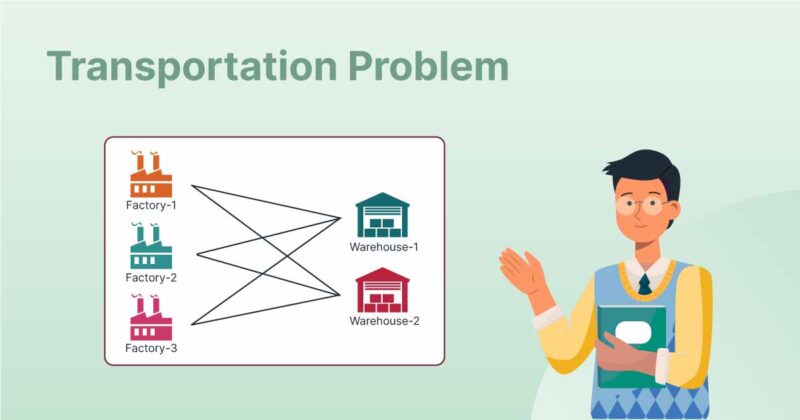Both transportation and assignment problems are integral aspects of linear programming. While the transportation problem focuses on the optimal distribution of resources and goods from various sources to destinations, the assignment problem deals with assigning tasks, resources, and jobs on a one-to-one basis. Both methods are essential for resource allocation, cost minimization, workforce planning, supply chain management, time management, and decision-making.
Transportation Problem
The transportation problem is a type of linear programming problem that aims to determine the most cost-effective way to allocate resources to different destinations. The objective is to deliver resources from multiple sources to various destinations while minimizing the total cost.
Components of the Transportation Problem
The transportation problem includes several key components that define its structure and influence how it is modeled and solved:
- Supply Nodes (Sources): Points where products are shipped from, such as factories, warehouses, or distribution centers.
- Demand Nodes (Destinations): Locations where products are delivered, including retail stores, consumers, and other warehouses.
- Cost Matrix: Displays the cost of transporting one unit of goods from each supply node to each demand node.
- Objective Function: Calculates the total transportation cost and aims to minimize it while fulfilling supply and demand constraints.
- Feasibility Conditions: Conditions that ensure a viable solution, such as ensuring that the total supply matches or exceeds the total demand.
Types of Transportation Problems
Transportation problems can be categorized based on various characteristics:
- Balanced Transportation Problem: The total supply equals the total demand.
- Unbalanced Transportation Problem: The total supply does not match the total demand.
- Symmetric Transportation Problem: The cost of transportation is the same in both directions.
- Asymmetric Transportation Problem: The transportation cost differs depending on the direction.
- Single and Multi-Commodity Transportation Problems: Based on the type of goods being transported.
Solutions for the Transportation Problem
There are several methods to find an initial feasible solution for the transportation problem:
- North-West Corner Method: Begins at the top-left corner of the cost matrix and moves either right or down to find an initial solution.
- Least Cost Method: Chooses the cell with the lowest cost to find an initial feasible solution.
- Vogel’s Approximation Method (VAM): Considers penalty costs to derive an initial solution.
- Modified Distribution Method (MODI): Refines the initial solution to ensure optimality, if necessary.
Assignment Problem
The assignment problem, a specialized type of transportation problem, involves assigning tasks or jobs to agents (such as workers or machines) in a one-to-one manner. Each task must be assigned to exactly one agent. The Hungarian method is commonly used to solve assignment problems.
Components of the Assignment Problem
The assignment problem includes several key components:
- Agents: Entities performing the tasks, such as machines, workers, or delivery vehicles.
- Tasks: Jobs or activities that need to be completed, which could include destinations, projects, or activities.
- Cost Matrix: Shows the cost associated with each agent completing a specific task.
- Decision Variables: Binary variables that indicate the assignment of agents to tasks.
- Objective Function: Aims to minimize the total cost of assignments.
Solutions for Assignment Problems
The Hungarian method is the primary approach for solving assignment problems. Alternatively, linear programming techniques can be employed, transforming the problem into a binary integer programming problem and using methods like the simplex method or specialized algorithms such as branch and bound. For large or complex assignment problems, heuristic and metaheuristic methods can be used to find solutions when exact methods are computationally expensive.
Difference Between Transportation and Assignment Problems
| Transportation Problem | Assignment Problem |
| Transportation problem deals with the distribution of goods and resources from multiple sources, such as warehouses and factories, to multiple destinations, which could be either the customers or the retail stores. | This is a special type of transportation problem that assigns the workers to destinations or jobs. |
| By addressing the transportation problem, we can easily minimize the total transportation cost. | By addressing the assignment problem, we can minimize the total cost or the time associated with completing the tasks. |
| Constraints on transportation problems include constraints on supply and demand. | Constraints with the assignment problem are that every single task will be assigned only to one resource, and each resource will be assigned to exactly one task only. |
| Transportation problems can be used in real-world scenarios like supply chain optimization, traffic flow optimization, distribution network design, etc. | Assignment problems can be applied to scheduling personnel for jobs, allocation of machines etc. |
| It can be solved using Vogel’s approximation or Modi method, Least Cost method, or Northwest method. | It can be solved using the Hungarian assignment method. |
| The number of sources and number of demands need not be equal | The number of sources should be equal to the number of demand. |
















